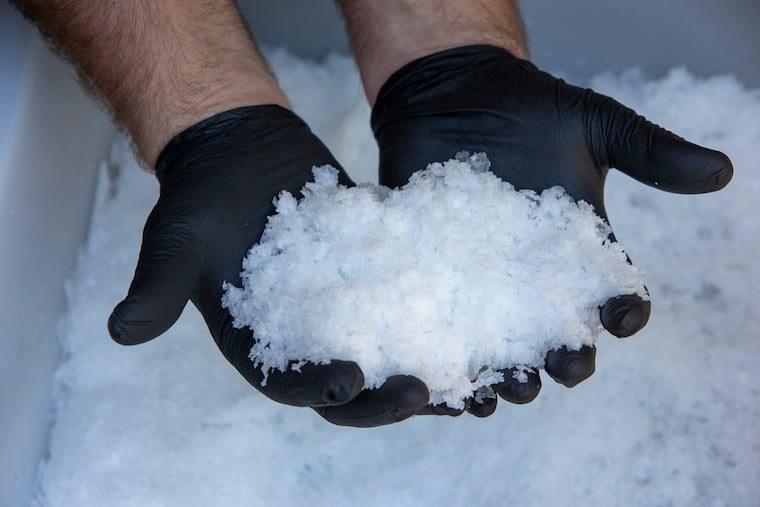Salt harvested from Delaware seawater is the ‘ultimate flavor enhancer’
Henlopen Sea Salt is hand-harvested from where the Delaware Bay and Atlantic Ocean meet.

Twice a week, Dave Burris wades into the briny waters at Cape Henlopen in southern Delaware and carries, bucket by bucket, 1,000 pounds of water 200 feet up the beach into his gray truck with the can’t-miss license plate, SALTMKR. “It’s pretty hard on the body,” says the 46-year-old.
It’s not the water he’s after. It’s the mineraly sea salt suspended in it.
In the middle of the COVID-19 pandemic, Burris quit his busy job as chief of staff in the state Senate and became a full-time salt maker. His company, Henlopen Sea Salt, produces the only sea salt made within at least 150 miles of Philadelphia.
Salt started as a hobby for the lifelong Delawarean. After seeing a video online about how sea salt is made, he thought: “Well, I have salt water.” He collected some local seawater and got to boiling. Burris describes his first batch as “pretty bad,” but he kept watching YouTube videos and tinkering until he nailed down his process and final product. “It’s not like there’s a sea salt school,” he jokes. Within a few years though, he’d learned how to “develop a good solid flake.”
Those good solid flakes became Burris’ go-to holiday present for friends and family, but the timing was never right to launch a business. Until 2020. Burris watched as pandemic-related closures led fellow food hobbyists and pros to launch businesses and sell direct to customers online.
After a decade of salt making, his product was “clean, briny, and almost sweet” with a craveable crunch. The taste reminded him of all those summers he spent with family swimming at Lewes Beach and digging for clams in Rehoboth Bay. He decided to dip a toe into the salty Cape Henlopen water with a test run of 1,200 1-ounce units in October.
“The first batch sold out in two hours, the second batch in an hour, and the third in 15 minutes,” Burris remembers. “And I thought, I should get some more boilers.” Henlopen Sea Salt was on a roll.
Eight months later, Burris makes sea salt 24 hours a day in a “bursting-at-the-seams” facility at his home in Lewes.
It starts with those heavy buckets of water pulled from the spot where the Delaware Bay and the Atlantic Ocean meet at the mouth of Cape Henlopen. “There’s something about the slushing where they meet,” says Burris, who has tested water from a number of spots. Back at home, he filters it, hard boils the water to reduce it, simmers it on low overnight and through the next day until the salt forms into crystals and flakes. Draining and drying takes a few more days.
“Everything is done by hand,” Burris explains. “From taking the water all the way to hand sealing envelopes and putting them in the mail.” He harvests 2.8 ounces of salt per gallon of water.
The salt found in those Delaware waters is “the ultimate flavor enhancer,” according to Burris. Don’t just throw it in pasta water though; this condiment is a finishing touch meant to be sprinkled with intention. “It brings out the flavors of whatever you’re cooking,” the salt maker explains. He recommends trying it on top of sautéed fresh peas, a steak, or a warm chocolate chip cookie. The minerality helps maintain the flake’s integrity so that it doesn’t dissolve quickly, even on steamy foods. The salinity and extra crunch boost the satisfaction level of almost any food it touches.
Burris is in good company with hissouthern Delaware neighbors. The region is rich in culinary resources, including family farms, orchards, lavender fields, seafood markets, locally-owned restaurants, and breweries. “You don’t usually see that in a community of 50,000,” Burris says. He’s been partnering with local companies and makers to get his sea salt into craft beer, chocolate bars, and even soap.
A wholesale operation may be on the horizon soon, but for the time being, just a few area restaurants are serving dishes with Burris’ salt. Henlopen City Oyster House’s Justin Jordan uses Henlopen Sea Salt in a kingfish crudo and three-time James Beard award semifinalist Hari Cameron featured it in a dark chocolate and caramel custard tart and sprinkled over shoestring potato chips.
To get his salt into more hands, Burris is looking for a larger commercial production space and more efficient ways to source salt water, if only to give his body a break from carrying it by hand. For now, home cooks and salt lovers can sign up for a newsletter to find out when new batches are available for purchase online.
Burris hopes his product will help spur more local sea salt operations up and down the East Coast. Each seaside region has its own “terroir,” he says. “Every town should have its own salt.”